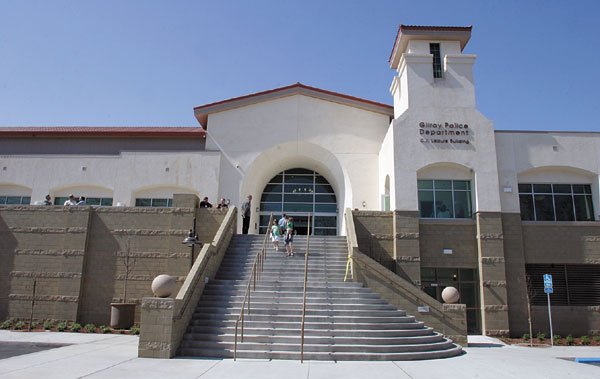Gilroy – The city will pay nearly $1.6 million to contractor SJ
Amoroso for construction delays that deviled the new police
headquarters, compensating the company for lost business. The
settlement, combined with other overruns, has bumped the building’s
price by $4.49 million, to more than $30 million.
Gilroy – The city will pay nearly $1.6 million to contractor SJ Amoroso for construction delays that deviled the new police headquarters, compensating the company for lost business. The settlement, combined with other overruns, has bumped the building’s price by $4.49 million, to more than $30 million.
“Nobody’s happy about the final number,” said Mayor Al Pinheiro, adding, “There’s so many different factors that have hit us during this process.”
The payment equals more than 7 percent of the building’s original cost, but it’s only a fraction of the $4.4 million that SJ Amoroso originally requested. The money does not pay for building repairs, but rather compensates Amoroso for business it could not accept due to delays resulting from the Gilroy building’s design, a total of 177 calendar days at $9,000 a day. Development impact fees, specifically earmarked for police capital projects, will pay the cost. Negotiations between the city and the contractor started more than a year ago, and the final figure was revealed to City Council in closed session earlier this year.
“Needless to say, we were quite far apart when the negotiations started,” said Bill Headley, co-project manager. “These are very subjective costs.”
City Council approved the settlement Monday night by a 6 to 1 vote; Craig Gartman was the dissenter.
“I can’t find any of this to be the city’s responsibility,” said Gartman in a Tuesday interview, stating that budget factors cited by Headley trail back to WLC Architects, construction manager Harris & Associates, and contractor Amoroso. “Why is the city of Gilroy being asked to pay for cost overruns by organizations we pay to manage this?”
City administrator Jay Baksa said WLC and Harris may, in turn, end up bearing some of the cost. The city attorney is looking into the city’s options for holding the two groups liable for design errors. Baksa said it was too early to describe what that process might entail.
Major projects usually plan for a cost overrun of 8 to 10 percent of project cost, said Headley. The city estimated the project’s unexpected costs at 3.9 percent, an estimate Headley now calls “overly optimistic.” In 2004, he explained, city officials thought that construction materials such as concrete and steel would decline in price after hitting pricey highs. They didn’t, and multiple construction errors caused expensive delays. Today, the project’s unexpected costs total 12 percent.
“That’s one of the places where we dropped the ball,” said Mayor Al Pinheiro. At the time, he said, project staff felt the building could stay within those limits. “It probably should have been highlighted to council.”
Project engineers acknowledged to council that the project’s unexpected costs would probably overrun 3.9 percent, said Baksa, but the city didn’t have the funds to budget for a higher percentage.
The two biggest factors in the building’s upped price were design conflicts and delays, Headley said. Of more than 80 change orders submitted for the project, Headley estimated that only 10 were requested by the police department. The others resulted from errors and miscommunications. For instance, conflicting plans routed ductwork through areas where other planners intended to place structural steel. In each such case, a change had to be made – and the changes cost money.
Gartman countered that such errors should be the architect’s responsibility.
“It’s like buying a car where someone has forgotten to put gears in your transmission,” he said.
Other significant errors included moldy paneling and faulty roofing. The city dodged paying for replacement panels, arguing that Amoroso’s contract required them to protect their work. The panels developed mold after workers failed to protect their work from winter rains. Amoroso will pay the entire $880,000 it cost to make the repairs, said Headley.
Mold “was a nonstarter for us” during negotiations, said Baksa. “We just said, ‘We’re not going to pay.’ ”
Amoroso representatives referred the Dispatch to a project manager who did not return calls before press time.
The errors have irritated some city staff. Councilman Dion Bracco said that calling him displeased with Amoroso would be “putting it lightly.”
Gartman was frustrated by the $30 million cost, saying that cost overruns should have been brought before Council as they occurred.
“We gave [city administrator] Jay [Baksa] $22 million to build this police station,” Gartman said. “He’s supposed to come to the Council to approve any cost overruns or changes to the project.”
City staff presented the increases to council in closed session earlier this year, said Baksa, though city staff couldn’t supply exact figures until the closed session meeting.
The $30 million figure is a significant increase from past estimates of the building’s cost. In 2003, some councilmen balked at a $26 million bid for the project. Project engineers originally tagged the building at $17.8 million. Commenting on the disparity between engineers’ estimates and contractors’ bids, then-Mayor Tom Springer said he couldn’t conceive that a $26 million bid would be accepted. Later, Amoroso submitted a lower bid of nearly $22.4 million, for a total estimated cost of $27.7 million including “soft costs” such as construction management and land purchases.
The city has yet to approve the total expenditure for the station: City Council is expected to vote on the additional $4.49 million in June.














